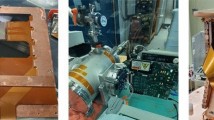Abstract
Excess low frequency noise is investigated for the first time in infrared MBE grown LWIR Hg1−xCdxTe double layer planar heterostructure (DLPH) detectors grown on lattice matched substrates. LWIR detectors having R0Aopt values at 40K in the 101–107 Θ-cm2 range have been characterized as a function of temperature between 120 and 20K. Detectors with R0Aopt≥103Θ-cm2 at 40K have theoretical diffusion limited performance down to 78K and detectors with R0Aopt ≥105 Θ-cm2 at 40K are within a factor of two of theoretical diffusion limited performance for T>65K. Activation energies extracted from noise (Vd=−100 mV) and dark current (Vd=−100 mV) vs temperature measurements were detector dependent. The activation energy for detectors with R0Aopt≈106 Θ-cm2 at 40K is ∼0.90*Eg to 0.99*Eg. The noise measured between 78 and 105K in the intermediate performance (R0Aopt∼103–104 Θ-cm2 at 40K) detectors are higher than the noise measured in the higher performance (R0Aopt∼105–107 Θ-cm2) detectors. In addition, the excess low frequency noise and the dark current at −100 mV in the intermediate and poor (R0Aopt∼101 Θ-cm2) performance detectors are temperature independent. For each detector measured, the activation energy extracted from noise (Vd=−100 mV) vs temperature measurements is equal to the activation energy extracted from the total dark current (Vd=−100 mV) vs temperature measurements. For different dark current mechanisms, the excess low frequency noise varies with temperature and also with area within statistical accuracy in the same manner as the total dark current through the detector. At 78K, the Tobin14 expression holds in the general sense for equal area detectors dominated by different current mechanisms and also for detectors with a wide range of implant dimensions (Aimp=3.85×10−7 cm2 to Aimp=6.25×10−4 cm2). Following measurements, the detectors were stripped of the passivation and overlaying metal layers and dressed by a defect etch to reveal defects in each detector. A correlation among noise, leakage current and defect type has been determined for each detector.
Similar content being viewed by others
References
J. Bajaj, J.M. Arias, M. Zandian, D.D. Edwall, J.G. Pasko, L.O. Bubulac and L.J. Kozlowski, J. Electron. Mater. 25, 1394 (1996).
A.I. D’Souza, L.C. Dawson, E.J. Anderson, A.D. Markum, W.E. Tennant, L.O. Bubulac, M. Zandian, J.G. Pasko, W.V. McLevige and D.D. Edwall, J. Electron. Mater. 26, 656 (1997).
J.M. Arias, J.G. Pasko, M. Zandian, S.H. Shin, G.M. Williams, L.O. Bubulac, R.E. DeWames and W.E. Tennant, Appl. Phys. Lett. 62, 976 (1993).
J.M. Arias, J.G. Pasko, M. Zandian, S.H. Shin, G.M. Williams, L.O. Bubulac, R.E. DeWames and W.E. Tennant, J. Electron. Mater. 22, 1049 (1993).
J.M. Arias, J.G. Pasko, M. Zandian, J. Bajaj, L.J. Kozlowski, R.E. DeWames and W.E. Tennant, Proc. SPIE Symposia on Producibility of II-VI Materials and Devices, Vol. 2228, (SPIE, 1994), p. 210.
S.H. Shin, J.M. Arias, M. Zandian, J.G. Pasko, L.O. Bubulac and R.E. DeWames, J. Electron. Mater. 22, 1039 (1993).
G.M. Williams and R.E. DeWames, J. Electron. Mater. 24, 1239 (1994).
M.B. Reine, K.R. Maschoff, S.P. Tobin, P.W. Norton, J.A. Mroczkowski and E.E. Krueger, Semicond. Sci. Technol. 8, 788 (1993).
J. Bajaj, G.M. Williams, N.H. Sheng, M. Hinnrichs, D.T. Cheung, J.P. Rode and W.E. Tennant, J. Vac. Sci. Technol. A 3, 192 (1985).
J. Bajaj, E.R. Blazejewski, G.M. Williams, R.E. DeWames and M. Brown, J. Vac. Sci. Tech. B 10 (4), 1617 (1992).
A.I. D’Souza, J. Bajaj, R.E. DeWames, D.D. Edwall, P.S. Wijewarnasuriya and N. Nayar, J. Electron. Mater. 27, 727 (1998).
P.Mackett, Properties of Narrow Gap Cadmium-based Compounds, EMIS Datareview Series No. 10, ed. Peter Capper, (Inspec, 1994), p. 188.
P.S. Wijewarnasuriya, D.B. Young, M. Zandian, R. Bailey, J. Waldrop, D.D. Edwall, W.V. McLevige, W. Tennant, J. Arias and A.I. D’Souza, J. Electron. Mater. 28, 649 (1999).
S.P. Tobin, S. Iwasa and T.J. Tredwell, IEEE Trans. Electron. Dev. ED-27, 43 (1980).
W.A. Radford and C.E. Jones, J. Vac. Sci. Tech. A 3 (1), 183 (1985).
Author information
Authors and Affiliations
Rights and permissions
About this article
Cite this article
D’Souza, A.I., Wijewarnasuriya, P.S., Dewames, R.E. et al. Excess low frequency noise/I-V studies in p-on-n MBE LWIR Hg1−xCdxTe detectors. J. Electron. Mater. 28, 611–616 (1999). https://doi.org/10.1007/s11664-999-0043-9
Received:
Accepted:
Issue Date:
DOI: https://doi.org/10.1007/s11664-999-0043-9




